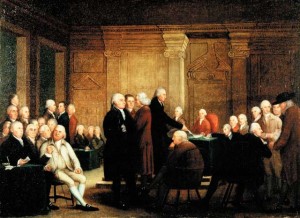
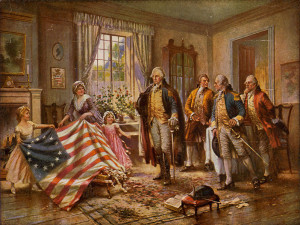
For the month of July and during the week preceding our Nation’s Independence Day celebration, I thought it would be the perfect opportunity to share the trip we made to Philadelphia back in 2009. During our visit we stayed at the Courtyard by Marriott across the street from City Hall and it proved to be a great choice because the historic and visitor sites were all located within an easy walking distance from the hotel. We would suggest starting a visit to the city by stopping at the Independence National Historic Park Visitor Center. This is the best place to get information such as location, hours and fees for all of the Philadelphia historic sites but most importantly it is the place to pick up timed tickets for a tour of Independence Hall.
Independence Hall
Independence Hall was originally known as the Pennsylvania State House which was used by their colonial government, later the building was loaned as a meeting place for the Second Continental Congress during the American Revolutionary War. It was here that the Congress appointed George Washington as the Commander in Chief of the Continental Army in 1775. Independence Hall is known as the birthplace of the United States and in the Assembly Room is where the Continental Congress debated and signed the Declaration of Independence in 1776 and the U.S. Constitution in 1787. Later, the room was used to display the Liberty Bell and original paintings of the Founding Fathers.
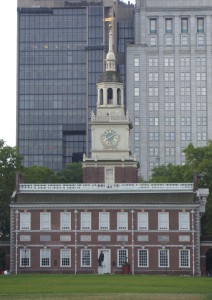
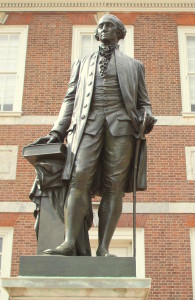
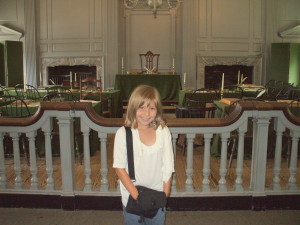
TRAVEL NOTE: Tickets are required to tour Independence Hall; the timed tickets are available for free on the day of a visit at the Independence Visitor Center starting at 8:30 a.m. Visitors can request a specific time and are limited to ten tickets, everyone needs a ticket even small children and infants. We advise visitors to arrive early for tickets because during the busy summer season tickets are often gone by 1 p.m.
Advanced Ticket Reservations are recommended if you required a specific date and time. Visitors can reserve tickets up to one year in advance through the National Park Reservation system. The tickets are free but there is a reservation fee of $1.50 per ticket, call 877-444-6777 or see the NPS website at www.recreation.gov for more information.
The Liberty Bell Center
The Liberty Bell Center was completed in 2003 during an extensive recent renovation of the Independence National Historic Park Mall. When visitors enter the building they will see several exhibits that tell the story of the Liberty Bell through displays and video presentations before finally reaching the glass enclosed area where the historic Liberty Bell hangs from what is believed to be the original yoke made of American elm. Visible across the street is Independence Hall where the Liberty Bell was displayed for a very long time before it was moved into a glass pavilion located a short distance away on the Independence Mall during United States Bicentennial celebration in 1976 until it moved to the permanent location in the Liberty Bell Center.
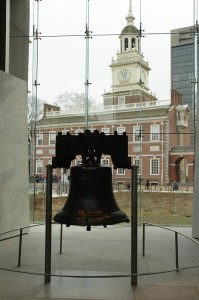
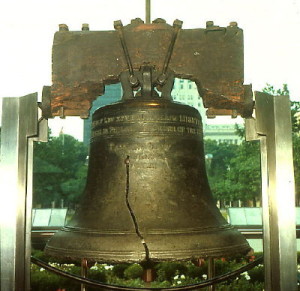
The Liberty Bell, a symbol of America and freedom, was ironically cast in London, England and arrived in Philadelphia in 1753 where it hung in the Pennsylvania State House bell tower. The Liberty Bell has a circumference is 14 feet and weighs 2,080 pounds and the yoke from where it hangs weighs about 100 pounds. It is made of 70% copper and 25% tin with traces of other metals. The inscription at the top of the bell reads, “Proclaim Liberty throughout all the Land unto all the Inhabitants therof”. Unfortunately, the first time the bell was rung, the 44 pound clapper cracked the bell. The bell was recast twice by local Pennsylvania craftsmen John Pass and John Stow, their names along with the city and the date appear on the front of the bell.
TRAVEL NOTE: Tickets are NOT required to visit the Liberty Bell Center, but the security lines can be very long during the busy summer months. Along with National security concerns after 9/11, a visitor tried to damage the Liberty Bell with a hammer in 2001. Since the incident visitors are no longer allow to touch the bell and it hangs out of reach guarded constantly by NPS security.
Franklin Court
Benjamin Franklin was one of the most fascinating people of early American history who lived in colonial and revolutionary Philadelphia. At a young age of 17 he moved there from Boston. He was a printer, author and publisher, as well as a scientist, inventor, postmaster, statesman and diplomat.
Located a short distance from Independence Hall is Franklin Court which is currently undergoing an $18 million renovation. Located on the site of Benjamin Franklin’s home, which was destroyed in 1812, is a 54 foot high steel “Ghost Structure” which was designed by Robert Venturi to represent the former residence.
Also located in the area of Franklin Court is an underground museum with displays of portraits, inventions and other items associated with Benjamin Franklin. One of the featured inventions is a reproduction of an instrument known as an Armonica, when consists of a set of glass bowls which rotate on a shaft and musical tones are produced when a finger is pressed onto the moistened edges of the bowls.
Located on Market Street in the Franklin Court area is the only active U.S. Postal Office that is not required to fly the American flag since at the time that Franklin was the Postmaster in 1775 Pennsylvania was still an English colony. Upstairs in the same building is a small U.S. Postal Museum which displays a selection of Franklin memorabilia including several original Pennsylvania Gazettes and historically important U.S. stamps.
TRAVEL TIP: This U.S. Post Office in Philadelphia is the only place that uses the historic postmark of “B. Free Franklin” to cancel stamps when mailing letters and packages. Come prepared with your own pre-written postcard to mail and it will make a unique and inexpensive souvenir!)
Betsy Ross Home
Located several blocks from Independence Hall and it is one of the most visited historic sites in Philadelphia. Betsy Ross is supposed to have rented this home that was originally built in 1740 and she lived there between 1776 and 1779 after the death of her first husband. Betsy Ross was a local seamstress who has been credited as the person who created the first American Flag.
According to the story told by Betsy Ross’s grandson, William Canby, who told the Pennsylvania Historical Society at the time of the 1876 Independence Day centennial celebrations, that George Washington was a customer of Mrs. Ross while he was the General of the Continental Army during the American Revolutionary War. Washington frequently visited Philadelphia to report to the Second Continental Congress and in June of 1776, he requested that Mrs. Ross create a flag according to his rough pencil drawing. She reviewed the design and made one suggestion, that the six point stars be changed to five point stars instead. As the years have passed, historians have found no documented proof to substantiate the claim but the legend still continues.
Christ Church and Burial Grounds
Christ Church is a privately managed historic site, part of the Independence National Historical Park, and located within walking distance from Independence Hall. Christ Church was originally founded in 1695 and the current building dates back to 1744. During and after the Revolutionary War many members of the Continental Congress, such as Benjamin Franklin, George Washington, John Adams and other prominent Philadelphia parishioners like Betsy Ross have attended services and for this reason Christ Church has been given a very significant role in the birth of the nation.
Considered one of the finest examples of an Early American church; the exterior of Christ Church has an impressive steeple which was added in 1754 making it the tallest structure within the British colonies for 56 years. Later, the interior was redesigned by Thomas Walter, the same architect who designed the U.S. Capitol in Washington, D.C. Displayed with Christ Church is the baptismal font from the 1300s donated by All Hallows Church in London, England that was used when William Penn was baptized. The pulpit that was built in 1769 and the chandelier which was originally installed in 1740 is still in use today.
TRAVEL NOTE: Christ Church is currently an active Episcopal parish but visitors can enter the Church for free, but it is suggested that a minimal donation be given to help maintain the Church and the nearby Burial Grounds. Docent talks about the Church’s history, the famous parishioners and the historic artifacts are given on a regular schedule throughout the day.
In 1719, Christ Church purchased two acres of land at the corner of 5th and Arch Streets. The Christ Church Burial Grounds became the final resting place for over 4,000 of the parishioners including five signers of the Declaration of Independence. Today, over 1,300 of the historical markers still remain and in 2003 plaques were placed in front of some of the deteriorating gravestones with the words that once appeared and have faded away.
When Benjamin Franklin died in 1790, he was buried in his family plot in the northwest corner of the burial grounds. In 1858, the descendants of Franklin requested that an opening be made in the brick wall and a metal fence was placed so the public could easily see Franklin’s grave site. Today, visitors show their respect for Franklin by leaving pennies on his grave as a remembrance of his words once written so long ago, “a penny saved is a penny earned.
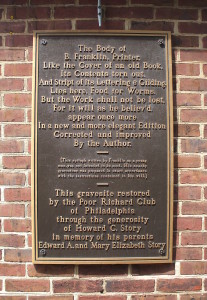
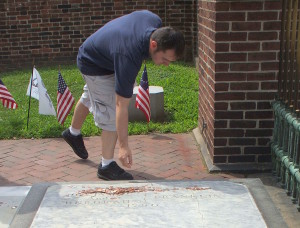
These are just some of the historic sites to see when visiting Philadelphia. Other places to visit within the Independence National Historic Park include: Declaration House, Elfreth’s Alley, Philosopher’s Hall and Carpenter Hall. In Philadelphia, PA – Part Two there are several more sites to see, such as the National Constitution Center, the U.S. Mint and the Franklin Institute and Science Museum. Another place of historic significance, which is located within an easy drive from Philadelphia, is Valley Forge National Historic Park.

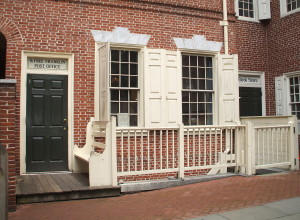
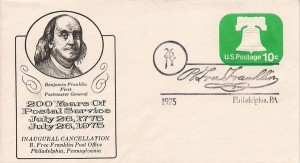
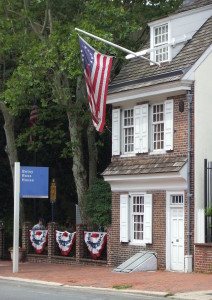
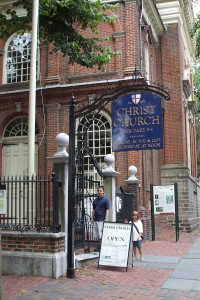
Pingback: Travel – Our National Parks | The Enchanted Manor